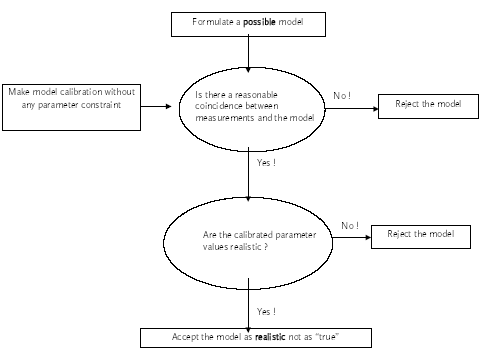|
| Front page | | Contents | | Previous | | Next |
Fate of Pyrethroids in Farmland Ponds
9 Aim and solution strategy, part II
Aim
The experimental results (part I) yield some information about the system being investigated. Much of this information can be extracted by simple mapping and direct interpretation of the
results using knowledge about the environmental chemistry and the possible processes taking place. However, further information may be hidden in the experimental results, and difficult
to discover by simple interpretation. In addition it is often difficult to generalise from experimental results to other conditions, and to set up qualified suggestions for improvements in
relation to similar future experiments. The following four interrelated tasks will be treated:
- Extract all possible information from the experimental results
- Generalise the results to other conditions
- Develop modelling formulations
- Make suggestions to improvements in relation to future experimental design
Possible models
Realistic models
The strategy is to suggest a series of "possible models" and then select one of them as the most appropriate. The process of suggesting possible models is subjective, as no general rules
for model formulation exist. In this investigation it is attempted to include all "possible" processes and transport phenomena in the models. Each possible model in the model analysis will
be investigated using the decision rules in Figure 2.1. The model is rejected if it is unable to describe the measurements even though the unknown model parameters values are optimized
to obtain the best agreement. If the model can fit the measurements reasonably well, then the optimized parameter values are revised and if they seem realistic then the model is realistic,
otherwise it is rejected.
Most likely model
The next problem is to identify the most likely model among the realistic models. A goodness of fit interpretation may be used in this selection. However, two models may turn out to
have nearly the same goodness of fit. In this case additional rules has to be applied in order to identify only one model.
The principle of simplicity
In this investigation the most simple model will be selected if two or more models can describe the experimental results equally well. However, this principle may be broken if additional
information about the system and the substance supports one of the models. E.g. in this case of hydrophobic pyrethroids, adsorption processes will be preferred instead of evaporation
processes. The problem in selecting a simple model is that the term "simple" can be difficult to quantify when two models of different principles are compared. So in that case the
criterion for the simplicity measure has to be carefully defined. The simplicity measure used in this investigation is the number of mechanisms involved. For example if two models equally
well describes the experiment, where one of the models includes transport mechanisms only while the other one includes both transport and other mechanisms e.g. degradation then the
first model (only transport) will be preferred.

Figure 9.1
The basic decision rules for identifying realistic models.
Grundlæggende beslutningsregler til identifikation af realistiske modeller.
| Front page | | Contents | | Previous | | Next | | Top |
Version 1.0 September 2004, © Danish Environmental Protection Agency
|